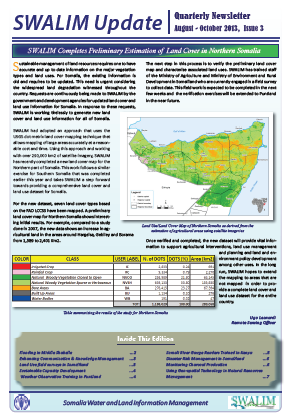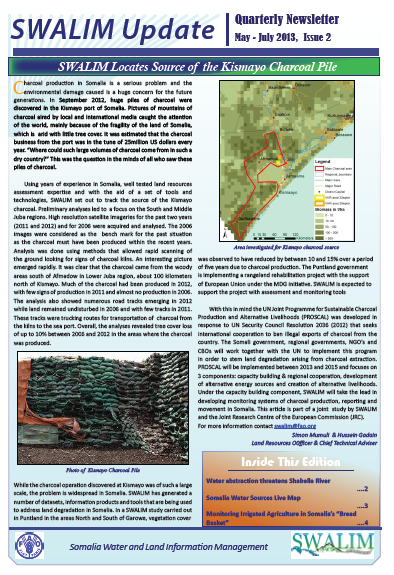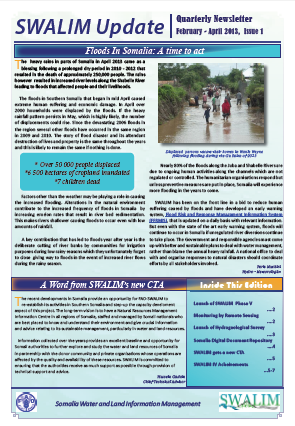Library Catalog
Latest Documents and Publications listed. Use search terms in the box below to find what you need
Range policy
Somalia is situated in northeastern Africa and covers an area of 637 660 km2. It has the longest coastline in Africa, being bordered by the Gulf of Aden to the north and the Indian Ocean to the east. The country is bordered by Kenya in the south, Ethiopia in the west and by Djibouti in the north-west. The country can be divided in five distinct physio-geographic zones differentiated by topography:
Publication Type:
Other
Publication Date:
Author:
Corporate Author:
SWALIM Update Issue 3
We are pleased to share Issue 3 of our quarterly newsletter “SWALIM Update”. The newsletter provides updates on SWALIM water and land information management activities such as: Completion of the Preliminary Estimation of Land Cover in Northern Somalia, training on Disaster Risk Reduction and Early Warning, how Geo-spatial Data and Technology ins being used in Natural Resources Management in Somalia, training in River Gauge Reading among others. We hope you will enjoy this edition. Your feedback will be highly appreciated.
Publication Type:
Newsletter
Publication Date:
Author:
Corporate Author:
SWALIM Update Issue 2
We are pleased to share Issue 2 of our quarterly newsletter “SWALIM Update” for 2013. The newsletter provides updates on SWALIM water and land information management activities such as: Monitoring and evaluation using remote sensing, the source of the Kismayo charcoal, assessment of the Gu 2013 Rainfall performance, capacity building activities that have taken place in the past 3 months among others. We hope you will enjoy this edition. You feedback will be highly appreciated.
Publication Type:
Newsletter
Publication Date:
Author:
Corporate Author:
Mapping Charcoal Driven Forest Degradation during the Main Period of Al-Shabaab Control in Southern Somalia
Following more than 20 years of civil unrest, environmental information for Southern Somalia is scarce while there is clear evidence that the war economy fueled by the conflict is rapidly depleting the country's natural resources and especially the woody biomass. Wood charcoal production is one of the most relevant businesses supporting war regimes such as the extreme Islamist group Al-Shabaab, which has ruled in Southern Somalia from 2006 to 2012 and is still occupying large areas. In this study, we map and quantify the tree loss suffered by the region due to the rapid increase in illegal charcoal production and export over recent years. Very high-resolution (VHR) satellite imagery is used to visually count charcoal production sites as a proxy of tree loss in two sample areas within the lower Juba region of Southern Somalia. The image interpretation allows mapping the charcoal production sites as well as estimating tree loss rates above 7% over 5 years. The results are crucial for understanding the exact dimension and effects of the loss of woody biomass and for planning conservation and recovery interventions in the concerned area.
Publication Type:
Journal Article
Publication Date:
Author:
Mr
Corporate Author:
SWALIM Update Issue 1
The newsletter provides updates on SWALIM water and land information management activities such as flood and drought early warning systems, hydro meteorological monitoring, status of the Somali water sources, land degradation, remote sensing monitoring, and water and land baseline and thematic studies. You will also be updated on the capacity development activities, particularly the training courses from which you can benefit. The training courses are open to all Somali stakeholders, especially women.
We hope you will enjoy this first edition of 2013 and those that will follow. You feedback will be highly appreciated and will help us improve future editions
Publication Type:
Newsletter
Publication Date:
Author:
Corporate Author:
W-22 Water Demand Assessment for the Juba and Shabelle Rivers
The Juba and Shabelle rivers are the only perennial streams in Somalia. They originate in Ethiopia, where over 90 percent of the stream flow is generated. The two river basins cover an area 174,600 km2 within Somalia. Basic monitoring of the two rivers and their basins has been ongoing in the previous SWALIM projects, laying a good foundation for more developed, continuous river monitoring and data processing (automatic weather stations, continuous discharge measurements, sediment and water quality monitoring together with pilot land degradation monitoring systems). The Juba and Shabelle basins are also called the ‘breadbasket’ of Somalia: It is the centre of agricultural and livestock production and home to the majority of the Somali population.
Publication Type:
Technical report
Publication Date:
Author:
Gadain H.M.
Corporate Author:
Somalia Water and Land Information Management, Nairobi (Kenya)
W-22 Qiimaynta Baahida Biyaha ee Juba iyo Shabeelle
Webiyaada Jubba iyo Shabeelle waa durdurrada kaliya ee joogtada ah gudaha Soomaaliya. Waxay ka soo dhashaan gudaha Itoobiya, halkaas oo ay ka yimaadaan biyaha qulqulaya boqolkiiba 90 wax ka badan. Dooxooyinka labada webi waxay fidsan yihiin aag dhul oo bedkiisu yahay 174.600 km2 gudaha Soomaaliya. La socod aasaasi ah ee labada webi iyo dooxooyinkooda ayaa waxay ka dhex socotay mashaariicdii hore ee SWALIM, oo u dhigaysa aasaas wanaagsan hab aad u horumarsan, kormeerid webi oo joogto ah iyo isku dubaridid xog (xarumo hawo automaatik ah, cabbiraado qulqul oo joogto ah, indha-indhayn caroo-degis iyo kormeerid tayo biyo oo ay weheliso habab tijaabo ah oo lagula socodo xaaluf dhul). Dooxooyinka Juba iyo Shabeelle waxaa sidoo kale loo yaqaan “Dambiisha kibista” Soomaaliya: Waa xarunta waxsoosaarka beeraha iyo xoolaha iyo hooyga dadweynaha Soomaaliyeed badankiisa.
Publication Type:
Technical report
Publication Date:
Author:
Corporate Author:
W-21 Climate CHange Impacts on Water Resources of Somaliland and Puntland
Identifying, assessing and developing groundwater resources is now an urgent priority for emergency relief and long-term development in all countries in the Horn of Africa affected by drought and water scarcity. As a response to this context, UNESCO, in May 2012, launched the initiative “Strengthening Capacity to Combat Drought and Famine in the Horn of Africa: Tapping Groundwater Resources for Emergency Water Supply” through support of the Government of Japan. The overall project aims to map-out drought-resilient groundwater resources in affected areas and strengthen regional capacities in managing groundwater for drought-preparedness. In order to take advantage of the established network and experienced profile of UNESCO’s partner FAO-SWALIM (Somalia Water and Land Information Management) in Somalia, an agreement of this UNESCO-FAO partnership was formalized that governs the framework of the overall project. As part of this project, SWALIM has recently finalized a hydrogeological survey and assessment in selected areas of Somaliland and Puntland which has come up with a wealth of information on potential groundwater resources which supplements SWALIMS previous activities in Somali water and land resources information management.
Publication Type:
Technical report
Publication Date:
Author:
Gadain H.M.
Corporate Author:
Somalia Water and Land Information Management, Nairobi (Kenya)
W-20 Sahan Biyo-jooloiyeed iyo Qiimayn Meelo laga Doortay Gudaha Soomaaliland iyo Puntland
Warbixintani waxay muujinaysaa qiimayn la sameeyey sanadkii 2011/2012 si loo ogaado biyaha kayd oo ka jira dhulka-hoose ee gudaha Soomaaliland iyo Puntland. Warbixintu waxay bixinaysaa faahfaahino ah xog ururinta iyo falanqaynta ay ka mid yihiin: - sahanno jooloiyadeed iyo oogo-dhuleed (geological and geophysical field surveys) oo geyiga duurka ah; iyo falanqayn xog jeedaalin dareeme fog (remote sensing data), iyo sidoo kale waxyaabo kala duwan oo laga soo saaray sahanka/qiimaynta.Waxsoosaarka sahanka biyo-jooloiyeed (hydrogeology) waxaa ku jira waxyaabo kale oo ku dhex jira: biyo-jooloiyeed iyo tayada biyaha Somaliland iyo Puntland oo heerka cabirku yahay 1: 750,000; khariidado hydrogeology ee 4 aagag oo la danaynayo oo qiyaasta cabirku tahay 1: 250,000; Warbixinta weyn ee qiimeynta iyo 4 lifaaq oo bixinaya faahfaahinada shaqada duurka, geophysics, jeedaalin dareeme fog iyo gundhig-xog. Warbixinta waxaa la filayaa inay isticmaalaan daneeyeyaal kala duwan ee waaxda biyaha, badanaa maamullada biyaha Somaliland iyo Puntland ee horumarinta iyo maaraynta khayraadka biyo-dhul-hoose ee gudaha gobolka.
Publication Type:
Technical report
Publication Date:
Author:
Corporate Author:
W-20 Hydrogeological Survey and Assessment of Selected Areas in Somaliland and Puntland - Report No W-20
This report documents an assessment carried out in 2011/2012 to identify potential groundwater aquifers in Somaliland and Puntland. The report gives details of the data collection and analysis including:- desk studies; geological and geophysical field surveys; and remote sensing data analysis, as well as various products generated from the survey / assessment. The products of the hydrogeology survey include among others: hydrogeology and water quality maps of Somaliland and Puntland at a scale of 1:750,000; Hydrogeology maps for 4 selected areas of interest at a scale of 1:250,000; main report of the assessment and 4 appendices giving details of the field work, geophysics, remote sensing and databases. The report is expected to be used by different stake holders in the water sector, mainly the water authorities in Somaliland and Puntland for development and management of groundwater resources in the region
Publication Type:
Technical report
Publication Date:
Author:
Muthusi F.M., Gadain H.M., Somalia Water and Land Information Management, Nairobi (Kenya) - SWALIM
Corporate Author:
SWALIM
Pages
 RSS feed [compliant with the Agris AP] |
RSS feed [compliant with the Agris AP] |  Agris AP XML
Agris AP XML





